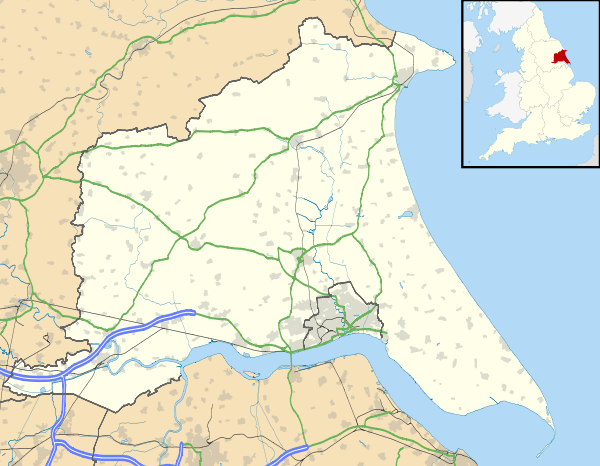Leven, East Riding of Yorkshire
Coordinates: 53°53′28″N 0°19′07″W / 53.891193°N 0.318574°W
Leven is a village and civil parish in the East Riding of Yorkshire, England. It is situated approximately 7 miles (11 km) west of Hornsea town centre, and north-west of the A165 road.
According to the 2011 UK census, Leven parish had a population of 2,433,[1] an increase on the 2001 UK census figure of 2,240.[2]
History
It is believed that the village of Little Leven - immediately west of the present village - began as far back as the days of the Ancient Britons, though Neolithic and Bronze Age human occupation of the area is known. Finds from Leven 'Carrs' (marshy land) have included axe heads, leaf-shaped swords, and a spearhead.
Three quarters of a mile west of Little Leven, at Hall Garth, is the site of Leven's former parish church - St Faith's - which was in use between 1350 and 1843. It is speculated that the original village of Leven was sited in its immediate vicinity though archaeological understanding of that area is sparse.
In 1823 Leven (then spelt 'Leaven'), was a civil parish in the Wapentake and Liberty of Holderness. The patronage of the church was under Sir William Pennyman. Population at the time was 658. Occupations included eight farmers, three wheelwrights, two blacksmiths, two butchers, three corn millers, five shoemakers, two maltsters, two grocers, a bricklayer, a schoolmaster, a parish clerk, and the landlords of The Minerva and the Blue Bell public houses. Four carriers operated between the village and Beverley and Hull twice weekly. There were two other carriers: one taking post by foot to Hornsea four times a week; and another to Hull once a week by water transport. Residents included the parish rector, three yeomen, a gentleman, and a merchant.[3]
The 1892 Bulmer's Directory of Hull and the East Riding states that the Manor of Leven was given to the Church of St John of Beverley by Edward the Confessor, and is listed in the Domesday Book as being amongst its possessions.
After the dissolution of the monasteries in 1547, ownership of the land reverted to the crown, to be bought by Sir Marmaduke Constable in 1557. About 1612, it appears that Sir Thomas Gresham owned some of the land, having received it as a gift from Queen Elizabeth I.
There was a proposal to build a Leven railway station as part of the North Holderness Light Railway but despite appearing on tile maps at several North Eastern Railway stations, the line was never constructed.
Leven was a small village with 400 inhabitants until 1964, after which a private housing estate was built (Barley Gate, Mill Drive, Westlands Way, Balk Close), and the village expanded to become a dormitory for workers mainly from Hull and Beverley. The population is now over 2,500. The village has two public houses: The New Inn and The Hare and Hounds as well as a member's club featuring live entertainment each week. Leven has amateur football, cricket and bowling teams.
The A165 road, opened 25 May 1994, was built after a campaign by residents to bypass the village.
Landmarks
The church dedicated to the Holy Trinity was designated a Grade II* listed building in 1968 and is now recorded in the National Heritage List for England, maintained by Historic England.[4]
Leven Canal, a Site of Special Scientific Interest links the village to the River Hull, although it is now closed. The canal was opened in 1804 having been cut by the order of Mrs Charlotte Bethel, Lady of the Manor. The 3 1/4 mile long canal started at the River Hull and was constructed to allow sailing barges to reach the warehouses at Canal Head on the southern edge of the village. Constructed in 1825, the two warehouses served two principal functions - storage of local grain ready for barge transport to Hull and Beverley and a depository for coal.
Linley Hill Airfield is nearby and is used for flying activities. Users include Hull Aero Club which was founded in the 1920s and numbered Amy Johnson among former members.[5]
Notable people
The Canadian politician George Dinsdale was born in Leven in 1887.[6]
References
- 1 2 "Key Figures for 2011 Census: Key Statistics: Area: Leven CP (Parish)". Neighbourhood Statistics. Office for National Statistics. Retrieved 5 February 2013.
- ↑ "2001 Census: Key Statistics: Parish Headcounts: Area: Leven CP (Parish)". Neighbourhood Statistics. Office for National Statistics. Retrieved 17 May 2008.
- ↑ Baines, Edward (1823). History, Directory and Gazetteer of the County of York. p. 362.
- ↑ Historic England. "Holy Trinity Church (1103456)". National Heritage List for England. Retrieved 16 August 2013.
- ↑ "Editorial" (PDF). The Windsock. Hull Aero Club (8). September 2010. Retrieved 8 December 2014.
- ↑ McCrea, Walter Jackson (1925). Pioneers and prominent people in Manitoba. p. 170. Retrieved 1 May 2013.
- Gazetteer — A–Z of Towns Villages and Hamlets. East Riding of Yorkshire Council. 2006. p. 7.
Further reading
- Allison, K J; Baggs, A P; Cooper, T N; Davidson-Cragoe, C; Walker, J (2002). Kent, G H R, ed. "North division: Leven". A History of the County of York East Riding: Volume 7: Holderness Wapentake, Middle and North Divisions. Institute of Historical Research. Retrieved 3 February 2014.
External links
 Media related to Leven at Wikimedia Commons
Media related to Leven at Wikimedia Commons- Leven in the Domesday Book
- Leven Village website

